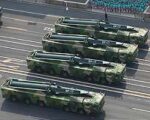Canadian UAV manufacturer Draganfly Inc. and U.S.-based Palladyne AI Systems have announced a strategic partnership aimed at developing autonomous drone swarms tailored for military and defense applications. The collaboration leverages Draganfly’s UAV platforms with Palladyne’s artificial intelligence software stack to create scalable, multi-domain unmanned systems capable of coordinated operations in contested environments.
Strategic Objectives Behind the Partnership
The partnership seeks to address growing demand among NATO-aligned militaries for cost-effective unmanned solutions capable of operating in denied or degraded environments. As peer adversaries invest heavily in electronic warfare (EW), anti-access/area denial (A2/AD) systems, and counter-UAS measures, Western forces are increasingly turning toward distributed autonomous systems that can operate with minimal human intervention.
According to the joint announcement made on April 30th, 2024, Draganfly will integrate its UAV platforms—ranging from quadcopters to fixed-wing drones—with Palladyne’s proprietary “AI Command & Control (C2)” architecture. This system enables real-time decision-making across heterogeneous drone fleets using edge computing and machine learning models optimized for tactical ISR (intelligence, surveillance, reconnaissance), perimeter security, electronic countermeasures support, and even kinetic strike coordination.
Palladyne’s AI-C2 Stack: A Modular Brain for Swarm Autonomy
Palladyne AI Systems specializes in modular artificial intelligence software designed to enable autonomous decision-making across unmanned platforms. Its flagship product—an adaptive C2 engine—uses reinforcement learning algorithms combined with probabilistic modeling to allow drones within a swarm to dynamically re-task based on mission parameters or threat inputs.
- Distributed Autonomy: Each node in the swarm can function semi-independently while still sharing data with other units via mesh networking protocols.
- Sensor Fusion: The system integrates EO/IR sensors, RF detection modules, GPS-denied navigation tools (e.g., visual odometry), and SIGINT payloads.
- Tactical Flexibility: Operators can define mission objectives at a high level (e.g., “secure perimeter,” “track convoy”) while the swarm self-organizes task allocation.
- NATO Interoperability: The architecture supports STANAG-compliant communications formats such as Link-16 gateways or VMF translation layers.
This approach aligns with emerging NATO doctrine emphasizing MUM-T (Manned-Unmanned Teaming) and distributed lethality concepts seen in programs like the U.S. Army’s Future Vertical Lift (FVL) or UK MoD’s Project Hydra.
Draganfly’s Role: Platform Integration and Field Deployability
Founded in the late 1990s and headquartered in Saskatoon, Saskatchewan, Draganfly has evolved from a commercial drone manufacturer into a dual-use technology provider supporting both civil emergency response and military ISR missions. Its current lineup includes:
- Commander Series: Multi-rotor drones optimized for payload delivery or ISR tasks with flight times exceeding 45 minutes under load.
- X4-P Platform: A ruggedized quadcopter used by public safety agencies; adaptable for tactical deployments with encrypted comms links.
- Fixed-Wing UAVs: Designed for long-endurance reconnaissance missions over wide areas; compatible with modular sensor pods including EO/IR turrets or LIDAR scanners.
The company will adapt these airframes to host Palladyne’s onboard compute modules while ensuring compliance with MIL-STD environmental standards. Initial prototypes are expected to undergo field testing by Q3–Q4 of FY2024 under undisclosed government contracts reportedly involving U.S.-aligned defense customers.
Spectrum of Defense Use Cases
The envisioned drone swarms are not limited to pure reconnaissance roles. According to statements from both companies’ leadership teams—including Draganfly CEO Cameron Chell—the integrated systems could support a variety of defense missions such as:
- Tactical ISR & Target Acquisition: Coordinated coverage of urban or forested terrain using multi-angle EO/IR feeds fused into a common operating picture (COP).
- C-UAS & Electronic Warfare Support: Swarm nodes equipped with RF jammers or decoys can disrupt enemy drones or radar networks through saturation tactics.
- Kinetic Coordination: While neither company currently manufactures armed drones directly, the C2 software could theoretically coordinate loitering munitions or FPV suicide drones launched from companion platforms.
- BDA & Post-Strike Reconnaissance: Autonomous return-to-target sweeps post-engagement allow rapid battle damage assessment without risking manned assets.
- Civil-Military Dual Use: Disaster response scenarios where swarms map damage zones or locate survivors using thermal imaging—an application already demonstrated by Draganfly during COVID-era deployments in North America.
Sovereign Tech Stack Emphasis Amid Geopolitical Tensions
A key driver behind this North American collaboration is the growing emphasis on sovereign technology stacks within NATO member states. With increasing scrutiny over Chinese-made components—especially DJI-branded drones—and export control concerns surrounding Israeli-origin technologies like Elbit’s Skylark series or Rafael’s FireFly loitering munition—the market is ripe for Western-aligned alternatives that offer transparency over supply chains and codebases.
Palladyne CEO Lance Ashdown emphasized this point during recent press briefings: “Our goal is not just technical innovation but ensuring our partners have full visibility into how these systems operate—from firmware layers up through cloud-based analytics.” This aligns with U.S. DoD initiatives like the Replicator program announced by Deputy Secretary Kathleen Hicks in August 2023—aimed at rapidly fielding thousands of attritable autonomous systems within two years using domestic tech bases only.










